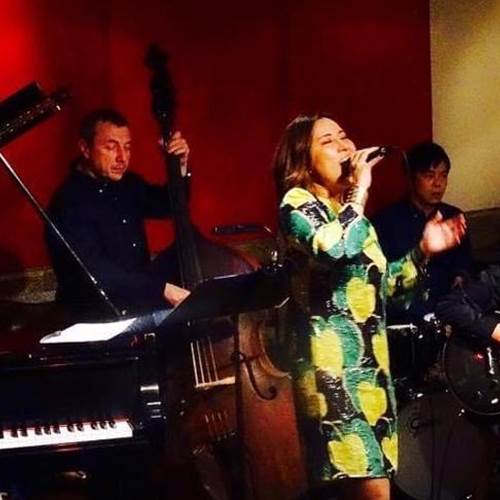
Singing With Pure EEase
Posted Monday, April 15th 2013 by David McCall
It’s time we had a talk about EE. Though it takes second place in the accepted listing of vowels, we use the EE to form the diphthongs of fourteen letters of our alphabet, making it one of the most...
It’s time we had a talk about EE. Though it takes second place in the accepted listing of vowels, we use the EE to form the diphthongs of fourteen letters of our alphabet, making it one of the most common sounds in English (and many other languages). It’s also a staple of countless vocal exercises. However, when we sing this ever-popular EE, so much of the time it becomes indistinguishable from IH, EH, or AY. In this vocal article I hope to tackle the EE in singing and its modification. I also hope to encourage all singers, from operatic horn-helmet wearers to fist-pumping pop princesses, to give pure EEs a chance.
Easy as 1, 2, ThrEE
When you sing a true EE in the lower to middle voice (Gents: A2-A3, Ladies A3-A4) there are three distinct characteristics to note:
- The tip of the tongue touches the bottom row of teeth while the middle of your tongue curls forward, over the bottom teeth. Avoid pressing the tongue too firmly. The rear of the tongue rises to touch your upper molars on either side. Your EE tongue will resemble a small-scale tidal wave, breaching the seawall formed by your bottom teeth.
- The lips relax to a neutral position. It’s very common for an EE to spread, sending a smile sprawling across your beautiful mug, but this should be avoided to maintain your nasal resonance. The more open the mouth, the more likely your breath, and therefore, resonance will escape (more on this later). Instead, think of smiling with your eyes (see “smizing” as created by Tyra Banks) or engaging in an “inner smile” that initiates at the outermost edges of your cheekbones.
- The cheeks hang down and sink into the face. Let them drape down the sides of your visage like Vincent Price’s luscious jowls. Like relaxed lips, long cheeks will help maintain nasal resonance by reducing the opening of the mouth.
Where’d EE go?
Now that you have your lower to middle voice EE, it’s time to sing in our higher mix and beyond…
But wait–you’re not singing EE anymore. Your “Sweet Nothing” sounds more like “Swit,” “Swayt,” or worse, “Sweat Nothing.” What’s happened to the EE that we just mastered? You may have heard of vowel modification, the adjustments we make in our vocal tract to make vowels feel better or easier to produce. No doubt you’ve heard it in action. With all due respect, check out the amazing Jennifer Holiday serving up one of musical theatre’s most enduring examples of vowel modification. Granted, some adjustments we make are in accordance to the style of music we’re singing, but nevertheless, some means of modification not only torture the lyrics at hand, but can prove troublesome to vocal health.
The tongue is the most common offender when it comes to morphing EE into any other vowel. A pure EE features the most forward tongue position of all vowels, so any tongue movement toward the throat will cause a shift in vowel sound. Feel your tongue and watch it in a mirror as you say these words:
BEAT! !
BET! !
SEAT! !
SET! !
FEEL! !
FELL! !
Notice that the tongue retreats from the EE position to properly pronounce any of the other words in the above lists. When our goal is to sing EE we can’t let the tongue retreat, creating “fillings” where there were once “feelings.”
The lips and cheeks must also resist the desire to spread wide when the pitch of our EE rises into the upper mixed voice. You’ve seen and probably felt the effects of the awful “Smile” technique: tight larynx, rigid tongue, and lack of resonance. Mid-note you feel that if you could just open the mouth wider, you’d be able to release some of the tension… And Whoops! There goes your EE into an AY or EH.
A New LEEase
Something must be done to relieve the tension that builds from pure EE in the upper mixed voice, but the answer isn’t opening the mouth wider or grinning and bearing it. The answer lies inside the mouth, above and behind the root of your tongue: the soft palate. Oh, yes, that subject of Justin Stoney’s brilliant Vocal Article. The soft palate is the entry way into the nasal cavity. You can feel it vibrate when you snore or snort (from laughing at the subject headings of this article). The tension we feel with the pure EE as we sing higher is the result of air leaving your body through an oral exhale as opposed to a nasal exhale (out of the mouth instead of out of the nose); therefore, our ability to sing any pure vowel in mixed voice hinges on our ability to exhale the air over the soft palate and through the nose.
Try saying the word “He” with the air leaving primarily through the mouth. You may feel your lips and cheeks wanting to spread to a smile. As you finish the initial burst of air created by the H sound and begin the vowel, you’ll feel a sudden throaty vibration.
Now try saying “He,” but with the air leaving through the nose. Leave the cheeks hanging and the lips neutral and think of sending the “H” sound up the back of your throat to the roof of your mouth. Try partially covering the mouth with your hand to help. Remember to keep your tongue in the true EE position. The second, nosey version of “He” is the correct modification for singing your pure EE in your upper mixed voice.
When you transfer this sensation of a nasal exhale to your sung EE, a funny phenomenon will occur. Your audience will hear pure EE, but you will experience the vowel as an IH or AY.
“But I didn’t think I was supposed to modify!” you exclaim.
Your vowel, no. Your resonance, yes! Resonance modification is an adjustment in your pronunciation that accommodates more air exhaling above your soft palate, while allowing you to pronounce the actual pure version of the vowel. Resonance modification at it’s best is a singer’s secret, not a telegraph to the audience that this is a tough note and a tough word to sing it on. If that were the case, there’d be a many an Elphaba singing, “It’s me. It’s MAY!”
If your EE vowel has been a source of tension, I hope you’ll give it another chance with modified resonance. I’ll wager that once you become a master at rerouting your air to the exit above the mouth, you’ll no longer feel the pains of singing your true EE vowel. Dare I say you’ll find yourself singing with “Pure EEase.”

David McCall
Senior Voice Teacher, Head of Vocal Development
David has become one of the leading instructors of Contemporary Voice in New York City, with clients ranging from Broadway singers (Billy Elliot, Matilda), Classical and sacred music singers, cantors in New York City Synagogues, to Professional Rock and Pop artists, some of which have toured and been signed to record contracts, appeared on shows like The Voice and American Idol, and performed at venues such as SXSW. Additionally, David has taught as a Master Teacher of Contemporary Voice for the NYSTA Comparative Vocal Pedagogy series.

A Practical Guide to Auditioning: Theatre Actor's Edition Pt. I
Where do you find out about auditions? What auditions should you go to? What should you expect when going to an audition? I will guide you through everything you need to know about auditioning as a theatre actor in 2023 in Part I of this series.

NYVC Singer Spotlight: Erika Matsuo
NYVC's Kacey Velazquez had the honor of speaking with New York-based, Japanese jazz vocalist Erika Matsuo about her artistic journey...

Am I "Cast-able"?
Before I became a professional music director, I had every intention of becoming a musical theatre performer. I studied four years at the prestigious Musical Theatre program at the University of Michigan, then, as was expected, pursued the life of an actor here in New York. But somewhere along the way, I made a turn and didn't quite end up where I'd planned...